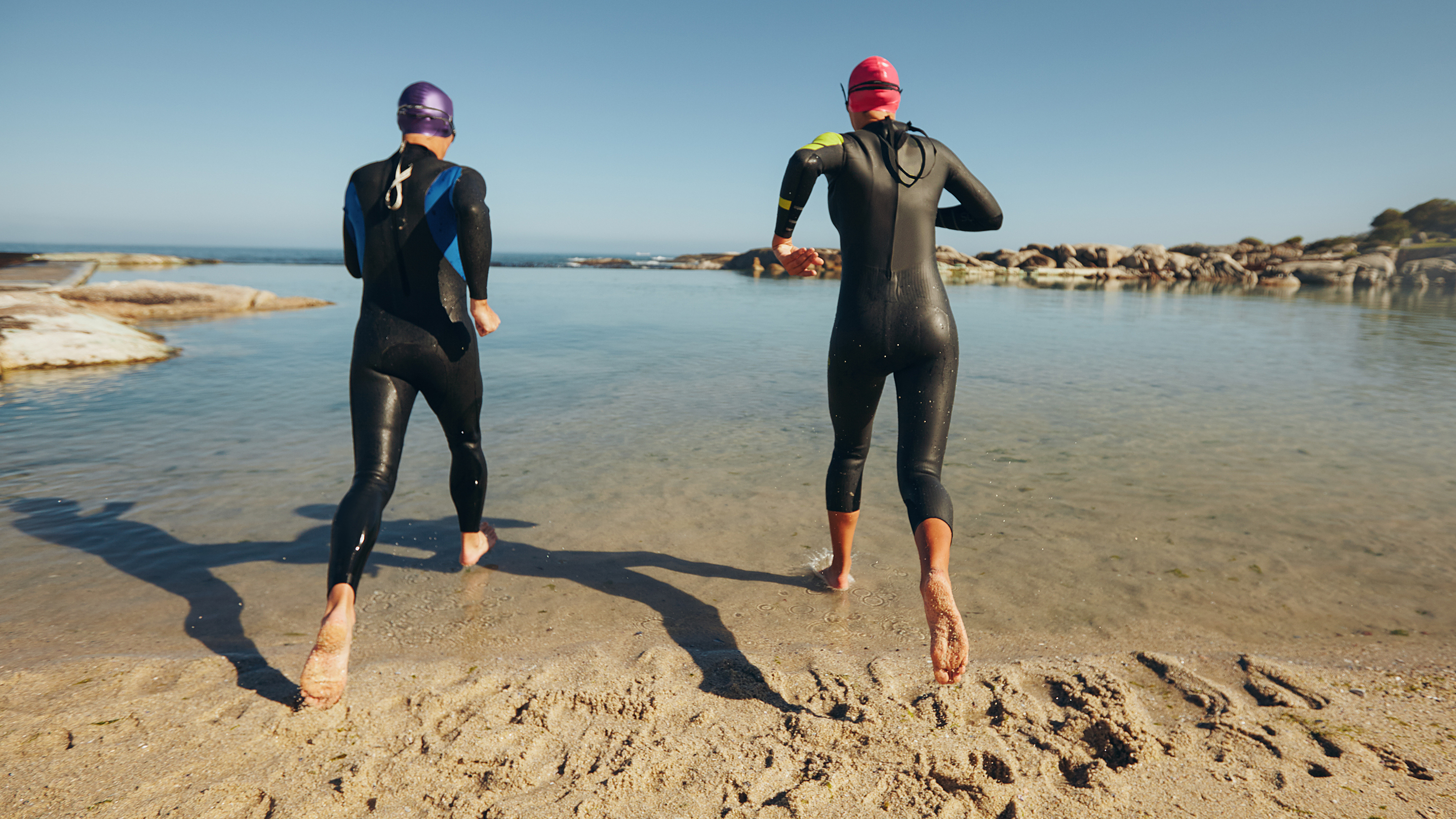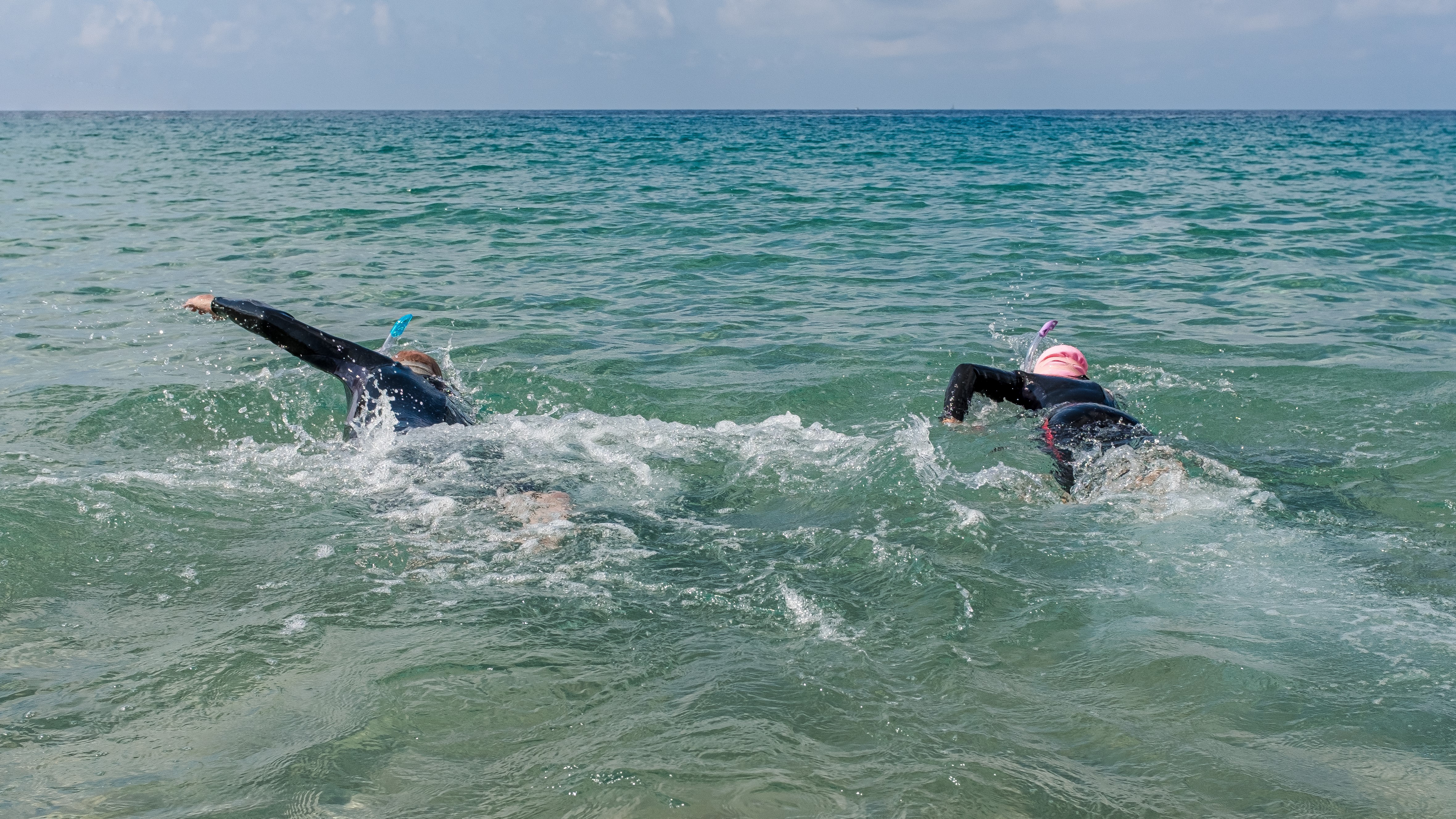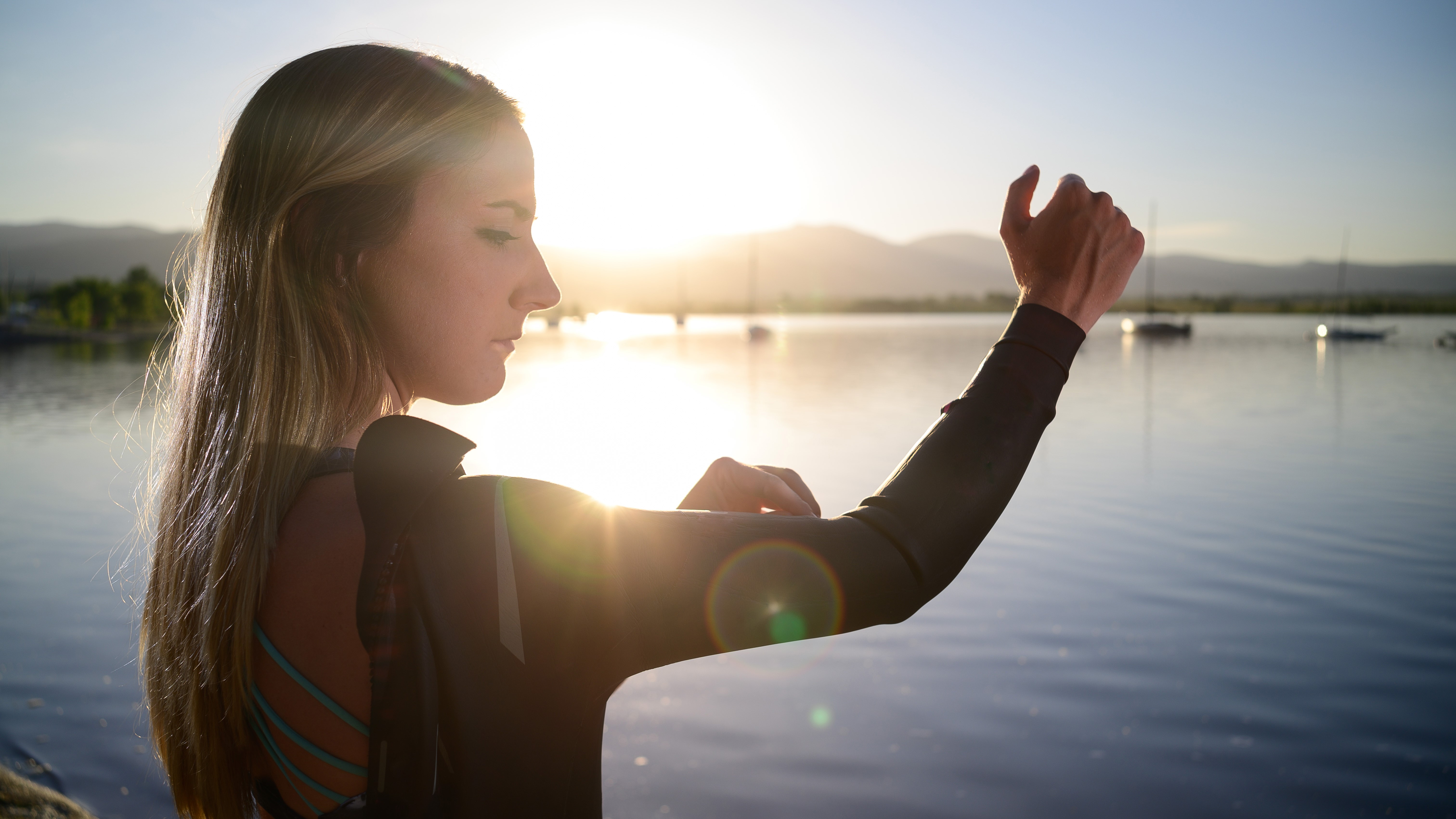
Swimming is a great activity if you’re looking to get in shape and stay that way. Hitting the local pool on a regular basis is perfect for burning calories, keeping trim and getting a low, or rather no impact workout. However, if you’ve been swimming in a pool for a while the repetitious nature of these sessions can become a little bit boring. Time for a change perhaps? Well, getting started with open water swimming could be the next logical step.
Open water swimming is just that; it’s a chance to hit stretches of coast, lakes and rivers all of which offer more of a challenge than just going up and down doing lengths in a standard indoor, or outdoor pool. Open water swimming has become very popular in the last few years with plenty of people deciding to take the plunge. In many cases it’s free and certainly easy to do if you know where to look, but it requires some thought before you hit the water.
Enjoy the benefits
Swimming in a pool is all well and good, and its health benefits are well documented, but open water swimming adds in some additional features. By its very nature, swimming in open water will probably be more of a revitalising experience than hitting a heated pool. Depending on the time of year it’s likely the water will be bracing at least and downright cold at the worst, unless you’re lucky enough to be open water swimming in the Mediterranean.
If you’re wearing the right kit, think wetsuit at the very least, this will stimulate levels of prolactin, which should result in better sleep. There’s also the overall buzz your body will get from being immersed in cold water that will fire up your system, clear your head and help regulate body temperature, control weight and improve your general mental wellbeing. Open water swimming is also said to give a boost to your immune system, which is no bad thing in the Covid-19 times we live in.
Alongside all of that there are the obvious physical benefits that can be enjoyed from regular open water swimming sessions. Unlike swimming in a pool there will be additional challenges as you swim. Aside from the challenging temperatures during your session you’ll be faced with choppy waters and even waves, which if you do it for any amount of time is a good workout in anyone’s book. Add on working against currents in some locations and it’s easy to see why open water swimmers frequently look in great shape.
Potential dangers
Open water swimming can be challenging both physically and mentally. It’s also not to be trifled with because in many cases the water conditions will be markedly different to the bog-standard pool experience. Even though many open water swimming locations are lakes and lochs, these are very different to the cool and often warm conditions of your local municipal pool.
Alongside lower water temperatures there are conditions to think about, both with the weather and the state of the water. Lakes can be deceptively changeable and even a slight switch in the wind speed and direction can completely alter the dynamic of an open water swim. Going to managed open water spaces for your early experience is a very good idea because there will frequently be better indicators on where to swim.
Get daily insight, inspiration and deals in your inbox
Sign up for breaking news, reviews, opinion, top tech deals, and more.

If you’re unfamiliar with a location there can be numerous hidden dangers, especially if you’re not sure about the depth of the water, any potential currents and, possibly, hidden obstacles beneath the surface. Remember to warm up before you take the plunge too because heading straight into cold water without first stretching and limbering up can result in muscle cramps. The swimming.org website has some great advice on ensuring you’re ready for the water before you hit it.
Taking precautions
You might need to pay fees in order to use some managed open water swimming locations. If you’re watching the pennies it may be tempting to bypass these locations and do your own thing. However, it’s prudent to use a place that’s frequented by other people simply because it’s going to be that little bit safer than if you’re just heading out somewhere with a friend or acquaintance.
Managed open water swimming areas often have the benefit of being a little better laid out in terms of giving you an idea of where to swim. Remember, if you’re open water swimming you’re always going to be at the mercy of the natural environment and many features that change frequently. Tides, river flows and all sorts of other organic factors can have a contributory factor in how the swimming landscape looks and feels.

Therefore, it’s always best to stick within your limits, use a location that you’re familiar with – even if conditions can change its dynamic, and make sure you’re accompanied. Having the right gear is also a given.
Crucially, remember to leave any valuables, cars and bikes secured in a location close by too. Once you get back, you’ll want to know that your preferred location for getting changed and warmed up will be within easy reach and, hopefully, still there.
Smartphone assistance
Thanks to modern technology there are apps that can assist you with your open water swimming interests too. We’re not just talking about the weather and tide times though. The Safer Seas Service app is one to have on your mobile device as it can help with key factors for deciding where to swim. One of the big issues these days is one of water quality. Doubtless you’ll have seen your fair share of reports in the media about the dwindling quality of water around our coasts, in our rivers, lakes and lochs.
You’ll find that this software can keep you up to date on water quality throughout the country and flags up any issues caused by heavy rainfall, pollution and incidents due to industrial or farming incidents. Water quality is a vital part of the open water swimming equation and, if things are as bad as they sometime seem, you might want to avoid swimming altogether if poor water quality levels are temporarily higher than usual.
Use common sense
There are also plenty of easy ways to check first before you decide on a location for your open water swimming session. Swimming in the sea is one of the most challenging environments due to its unpredictable nature and many hidden hazards. Consider if you’ve ever seen anyone else swimming in an area you fancy taking on, because if you’ve never seen a swimmer then chances are it might be more dangerous than it looks.

Many seaside locations might look inviting and offer plenty of potential challenges, but the sea can be hard going for anyone, let alone a pair or group of beginners. Swimming off a beach with a lifeguard presence is always a bonus and there is the additional benefit in season of the red and yellow flags that indicate it is safe to swim. Stick within those boundaries if you’re still finding your feet and avoid the water altogether if there’s a red flag flying.
Ultimately, try and use some common sense. If you get a bad feeling about a location or it looks too good to be true it may be wise to avoid it altogether. There aren’t always signs warning of potential hazards.
Waves and more
Open water swimming isn’t just about dealing with the cold and natural conditions. Depending on the location you’ll need to consider the tides, any currents or rips currents that may occur as a result of tidal changes and wave patterns. Waves and currents can be unpredictable and will catch you out. You’ll certainly want to try and stay calm if you feel the conditions aren’t as expected. Don’t beat yourself up if you decide that your open water swimming sessions is proving a little too challenging.
Before you start, be sure to let people know where you are and what you’re doing, along with swimming with a pal. Obvious easy wins are to have a very visible swimming cap or hat and a swimming float is sensible as it helps with being seen by other people and lets things like boats and jetskis spot you. This is especially so in water that frequently has sizeable waves that can make you disappear as the swell goes up and down.
Equipment you'll need
Compared to some sports the outlay required to join the open water swimming throng is relatively low, but as always it depends on the quality of the kit that you buy. You’ll certainly want a decent wetsuit, and if you can stretch to a good quality one then so much the better. They may cost more but they’ll last longer, stand up to the pounding delivered by different types of weather conditions and water, plus you can get one that fits a little better if the budget is raised.
Think about some quality swimming goggles too, that swimming cap, plus thermal wear including swim socks and gloves, earplugs, tow floats and waterproof bags and pouches for essentials that you can’t leave behind on shore. A fitness tracker or swimming watch is a great idea for things like watching the time as well as monitoring your overall health stats.

You should also factor in some budget for gear that can be used when you emerge from the water, so durable changing robes are a good idea for warmth and drying, plus towels, a flask for something hot and water containers for staying hydrated when it’s warmer all make sense too. Waterproof shoes or even flip flops are handy for getting to the water on pebble-strewn shorelines too. A first-aid kit isn’t a bad idea either for any scrapes from the same.
Support structure
Thanks to the growing popularity of open water swimming there are plenty of options to choose from when it comes to getting support. If you’re a complete newbie it’s well worth investigating official bodies as well as hobbyist outlets and clubs. This is always the best way to get an express lane into the world of a new sport or activity because you’ll generally be communicating with bona fide enthusiasts. They probably won’t be trying to sell you anything either, which means you won’t end up having lots of kit unnecessarily foisted on you.
Equally, clubs and their legions of enthusiasts will also be able to advise on the right kit to buy, the places to get it without being ripped off and, possibly, get you a discount into the bargain. The other major bonus by talking to enthusiasts and people already doing open water swimming is that you’ll get first-hand experience of how to do it properly and, above all, safely. Crucially, you should be able to find people to go open water swimming with because doing it solo is not an option.
Finding resources
Alongside over 150 clubs and hobbyist groups in England alone, there are plenty of official organisations dedicated to the sport of open water swimming. Taking it from the top there is the World Open Water Association (WOWSA), which is a handy resource for finding out about the bigger picture. It’s also a useful starting place for hooking up with the right contacts if you’re considering doing some open water swimming while on holiday overseas.
In the UK the Outdoor Swimming Society is a great site that can hook you up with like-minded individuals and offers lots of advice on wild swimming groups, events throughout the year and has a plethora of resources for buying gear too. Similarly, the swimming.org website is another place to head for with its beefy selection of latest news, tips on getting started, coaching contacts and events listings. Enjoy the water!
This article is part of TechRadar's Get Fit in 2022 series – a collection of ideas and guides to help get your new year's health goals off to the right start, whatever your current level of fitness.
- We've tested and ranked the best swimming watches
Rob Clymo has been a tech journalist for more years than he can actually remember, having started out in the wacky world of print magazines before discovering the power of the internet. Since he's been all-digital he has run the Innovation channel during a few years at Microsoft as well as turning out regular news, reviews, features and other content for the likes of TechRadar, TechRadar Pro, Tom's Guide, Fit&Well, Gizmodo, Shortlist, Automotive Interiors World, Automotive Testing Technology International, Future of Transportation and Electric & Hybrid Vehicle Technology International. In the rare moments he's not working he's usually out and about on one of numerous e-bikes in his collection.
